|  Diego
de Castro was born in Pirano (Istria) on the 19th August
1907, descending from a family that lived in Castrum Pyrrhanense
for over one thousand years. Diego
de Castro was born in Pirano (Istria) on the 19th August
1907, descending from a family that lived in Castrum Pyrrhanense
for over one thousand years. 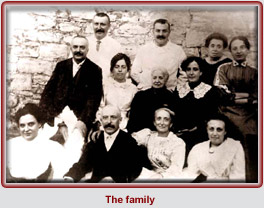 Traces
of the founder of the family, Venerio de Augusto de Castro Pirano,
can be found in official documents dated 933, but a historical-genealogical
reconstruction Traces
of the founder of the family, Venerio de Augusto de Castro Pirano,
can be found in official documents dated 933, but a historical-genealogical
reconstruction begins with Ottaviano de Castro from Pirano d'Istria, born in
1430.
begins with Ottaviano de Castro from Pirano d'Istria, born in
1430.
De Castro attends the first years of the primary school in Pirano.
Later his family moves to Salvore and later to Trieste where he
obtains his High School certificate in 1925. Besides this cultural
background, he already has an important store of memories and
experiences, sometimes difficult and even tragical, concerning
the years he spent at Salvore and then in Trieste. Salvore was
one of the most important strategical points on the Italian-Austrian
front during the first world war.
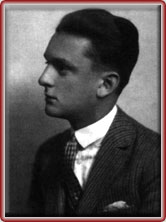 He matriculates in Rome at the Faculty of Law. In 1927 he publishes
his first scientific work in the "Bollettino dell'Istituto statistico-economico"
of Trieste University (L'attrazione matrimoniale tra individui
di uguale religione a Trieste. 1904-1925). He graduates in
1929 with first class honours, discussing a thesis about the theoretic
formulation of criminal-judicial statistics, that was published
as XXIV volume of the "Annali di Statistica".
He matriculates in Rome at the Faculty of Law. In 1927 he publishes
his first scientific work in the "Bollettino dell'Istituto statistico-economico"
of Trieste University (L'attrazione matrimoniale tra individui
di uguale religione a Trieste. 1904-1925). He graduates in
1929 with first class honours, discussing a thesis about the theoretic
formulation of criminal-judicial statistics, that was published
as XXIV volume of the "Annali di Statistica". Then he takes part in a competition at the University of Rome
and becomes the assistant of Professor Rodolfo Benini for economic
subjects and with statistic. In the meantime he attends courses
at the School of Statistics (The Faculty of Statistics did not
exist yet). In 1931 he qualifies free for statistic university
teaching and on 16th November of the same year he becomes
official professor in the Faculty of Law at the University of
Messina. Then he teaches for a year at the University of Naples.
At the same time he becomes the Consultant for economic services
of the industrial workers' Confederation in Rome; he will carry
on this task till 1943.
Then he takes part in a competition at the University of Rome
and becomes the assistant of Professor Rodolfo Benini for economic
subjects and with statistic. In the meantime he attends courses
at the School of Statistics (The Faculty of Statistics did not
exist yet). In 1931 he qualifies free for statistic university
teaching and on 16th November of the same year he becomes
official professor in the Faculty of Law at the University of
Messina. Then he teaches for a year at the University of Naples.
At the same time he becomes the Consultant for economic services
of the industrial workers' Confederation in Rome; he will carry
on this task till 1943.
From 1932 to 1935 he teaches also at the Superior Institute of
Economic and Commercial Sciences of Turin (that later became the
Faculty of Economy and Commerce) and in the mean time at the Faculty
of Law of the same town. In 1936 he becomes full Professor of
Statistics at the Faculty of Economy and Commerce of Turin, where
he will teach also Demography. In that Faculty, in 1938, he founds
the Institute of Statistics which, he directs till 1972. This
institute, with the setting up of departments, has recently become
"Diego de Castro Department of Statistics and Mathematics applied
to human sciences".
His name is therefore still present in that historical palace
in Piazza Arbarello, but above all in the minds of those who,
in those lecture-halls, and not only there, could listen to his
lessons in which he showed the intellectual curiosity that was
one of the great gifts of his intelligence.
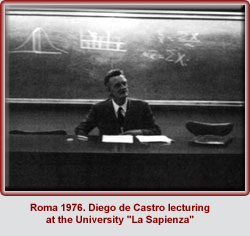 After teaching in Turin for 37 years, he moves to Rome at the
Faculty of Economy and Commerce. He will teach Statistics and
Demography in that Faculty for 12 years more. He reaches retirement
age in 1982 after 50 years of didactic and scientific activity.
In 1983 the President of the Italian Republic Sandro Pertini appoints
him " Professor Emeritus".
After teaching in Turin for 37 years, he moves to Rome at the
Faculty of Economy and Commerce. He will teach Statistics and
Demography in that Faculty for 12 years more. He reaches retirement
age in 1982 after 50 years of didactic and scientific activity.
In 1983 the President of the Italian Republic Sandro Pertini appoints
him " Professor Emeritus".
At the end of the 30's, his constant commitment in the scientific
research and in the didactics make him become a member of the
Economic-Demographic and Statistic Italian Society of which he
was also President. He was Vice-President of the Italian Institute
of Anthropology. In 1946 he was appointed Fellow of the Royal
Statistical Society in London; later he becomes an honorary member
of the Italian Society of Statistics and of the Institute for
the History of the Italian Risorgimento; he is also a member for
life of the International Institute of Statistics.
From 1927 to 1997 he published many works in the field of demographic,
economic, social, docimologic, syndacal and judicial statistics.
He has been interested in this last field since 1934, when he
wrote Metodi per calcolare
gli indici di criminalità, that
was judged by the Department of criminology, of the University
of Philadelphia, the best work available at the moment and from
the XIX century. In this field he was considered the most expert
Italian student of legal statistics, of criminality and of criminology.
From 1941 to 1981 he contributed to the newspaper "La
Stampa" of Turin with about 400 articles. In the first years
after the war he contributed also to "Il Giornale di Trieste"
and since 1952 he his contributing to "Il
Piccolo" of Trieste.

Though strongly attached to the University, all through his life
de Castro has also devoted himself to a diplomatic activity, that
starts when he is obliged to interrupt his scientific and didactic
activity owing to the war.
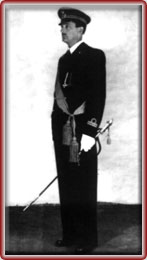 In
the spring of 1941 he is called up for military service. Since
he had not previously served in the Army, because he was the only
son of a widow mother, he can choose the arm he wants to join.
He joins The Navy as a Lieutenant in the Service Corps. He remained
for four months in the Department of the Navy. He was then appointed
as a member of the Interministerial Administrative office of prices.
Later on de Castro is involved in the politically-military events
of the country. In
the spring of 1941 he is called up for military service. Since
he had not previously served in the Army, because he was the only
son of a widow mother, he can choose the arm he wants to join.
He joins The Navy as a Lieutenant in the Service Corps. He remained
for four months in the Department of the Navy. He was then appointed
as a member of the Interministerial Administrative office of prices.
Later on de Castro is involved in the politically-military events
of the country.
About the end of 1943 he becomes a member of the "Comitato Giuliano"
of Rome and goes back to the Navy Ministry. In 1946 the Italian
Government entrusts him with tasks concerning the preparation
of the peace treaty. He is sent to England and to the United States.
From July 1952 to April 1954 he is also the diplomatic representative
of Italy with the Allied Military Government in Trieste and the
political Counsellor of the Officer Commanding the Anglo-American
Zone - General John Winterton. For Austria, Italy Yugoslavia and
Slovenia these are decisive years, owing to the problem of defining
their borders after the second world war. De Castro can be considered
a protagonist of one of the most interesting and disputed pages
of our times and one of the greatest experts of the problems concerning
the Italian eastern borders. He knows very well the feelings,
the reactions, the hopes, the illusion of the Italians of Trieste,
of Istria and of the whole of Italy.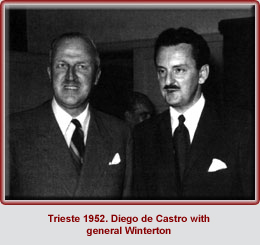 For
Austria, Italy Yugoslavia and Slovenia these are decisive years,
owing to the problem of defining their borders after the second
world war. De Castro can be considered a protagonist of one of
the most interesting and disputed pages of our times and one of
the greatest experts of the problems concerning the Italian eastern
borders. He knows very well the feelings, the reactions, the hopes,
the illusion of the Italians of Trieste, of Istria and of the
whole of Italy. For
Austria, Italy Yugoslavia and Slovenia these are decisive years,
owing to the problem of defining their borders after the second
world war. De Castro can be considered a protagonist of one of
the most interesting and disputed pages of our times and one of
the greatest experts of the problems concerning the Italian eastern
borders. He knows very well the feelings, the reactions, the hopes,
the illusion of the Italians of Trieste, of Istria and of the
whole of Italy.
De Castro wrote on these problems five books and many articles
in newspapers and magazines. In particular two books are the most
complete and detailed descriptions about the Italian political
and diplomatic action from 1943 to 1954: Il problema di Trieste.
Genesi e sviluppi della questione giuliana in relazione agli avvenimenti
internazionali (1943-1952) published in 1953 and
published in 1953 and 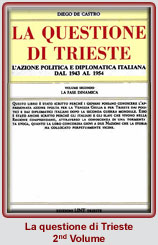 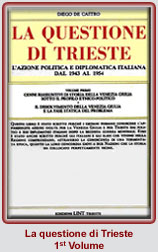 La questione di Trieste. L'azione politica e diplomatica italiana
dal 1943 al 1954,
La questione di Trieste. L'azione politica e diplomatica italiana
dal 1943 al 1954, published in 1981. In this last book he cleverly blends anecdotes,
reflections and faithful reconstructions of crucial events - especially
concerning the 40's and the 50's, the period of the so-called
"Trieste problem". Thanks to his long and rich personal experience
he can recall a century of difficult and controversial events,
especially for Trieste and Istria, countries deeply involved in
the first and second world war. He has always shown for these
countries an impassioned commitment both as a diplomat and as
a historian.
published in 1981. In this last book he cleverly blends anecdotes,
reflections and faithful reconstructions of crucial events - especially
concerning the 40's and the 50's, the period of the so-called
"Trieste problem". Thanks to his long and rich personal experience
he can recall a century of difficult and controversial events,
especially for Trieste and Istria, countries deeply involved in
the first and second world war. He has always shown for these
countries an impassioned commitment both as a diplomat and as
a historian.
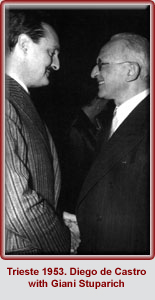 De
Castro has been a careful observer of events and has left a detailed
and clear testimony of them in his book Memorie
di un novantenne, Trieste e l'Istria, De
Castro has been a careful observer of events and has left a detailed
and clear testimony of them in his book Memorie
di un novantenne, Trieste e l'Istria, where he sums up these memories; the ones of the years he has
spent in Pirano before the first world war and many others, to
prove his intense diplomatic activity during the second world
war. And at the end he writes: "If a human being has taken part
in historical events as a private citizen or a person invested
with some public responsibility, he sometimes ends up by writing
an almost autobiographic work, describing facts of his own life
that unfortunately are not statistically casual samples of life
in general … Now that I am already ninety I have learnt an Arabian
proverb that compares the death of an old man to the death of
a library. Thus I have realised that in a way I am too a library
that is dying. If I compare my culture and the one of my old colleagues,
if I compare my experience and the experience of those who lived
with me in times much more difficult than nowadays, I am aware
that today's young people examine single subjects more carefully
than we did. And yet they have lost that vision, both scientific
and practical or political more general and less deep, that was
typical of our culture and of our way of thinking and acting.
The story you have read, and I like to define it a story, is an
attempt of not destroying completely that library that I have
only recently realised I am".
where he sums up these memories; the ones of the years he has
spent in Pirano before the first world war and many others, to
prove his intense diplomatic activity during the second world
war. And at the end he writes: "If a human being has taken part
in historical events as a private citizen or a person invested
with some public responsibility, he sometimes ends up by writing
an almost autobiographic work, describing facts of his own life
that unfortunately are not statistically casual samples of life
in general … Now that I am already ninety I have learnt an Arabian
proverb that compares the death of an old man to the death of
a library. Thus I have realised that in a way I am too a library
that is dying. If I compare my culture and the one of my old colleagues,
if I compare my experience and the experience of those who lived
with me in times much more difficult than nowadays, I am aware
that today's young people examine single subjects more carefully
than we did. And yet they have lost that vision, both scientific
and practical or political more general and less deep, that was
typical of our culture and of our way of thinking and acting.
The story you have read, and I like to define it a story, is an
attempt of not destroying completely that library that I have
only recently realised I am".

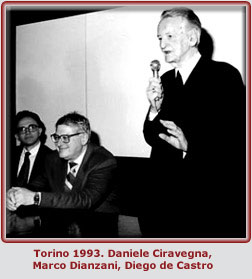 His
capacity of analysing contemporary society, his capacity of devising
solutions and, at times, of being in advance of his time, his
clearness of mind and coherence, his wide culture and his competence
in all Italian economic sectors caused him to be considered one
of the greatest Italian statistics. He received many official
acknowledgements for his long scientific and didactic activity,
as well as for the big diplomatic contribution in the years after
the second world war. We mention only some: "Diploma di Medaglia
d'Oro ai Benemeriti della Scuola della Cultura e dell'Arte" (1965),
"San Giusto d'Oro Trieste" (1981), "San Giorgio d'Oro Comunità
degli Italiani 'Giuseppe Tartini' di Pirano" (1993). His
capacity of analysing contemporary society, his capacity of devising
solutions and, at times, of being in advance of his time, his
clearness of mind and coherence, his wide culture and his competence
in all Italian economic sectors caused him to be considered one
of the greatest Italian statistics. He received many official
acknowledgements for his long scientific and didactic activity,
as well as for the big diplomatic contribution in the years after
the second world war. We mention only some: "Diploma di Medaglia
d'Oro ai Benemeriti della Scuola della Cultura e dell'Arte" (1965),
"San Giusto d'Oro Trieste" (1981), "San Giorgio d'Oro Comunità
degli Italiani 'Giuseppe Tartini' di Pirano" (1993). 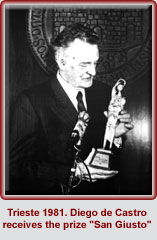
The Italian community "Giuseppe Tartini" of Pirano, the beloved
town where de Castro spent his early years, in 1993 named after
him their library, that consists now of 4.200 books. In future it will receive also
about 10.000 books (mainly of statistics) from de Castro's personal
library; it will become an important cultural reference point
for the experts of this sector all over Europe.
that consists now of 4.200 books. In future it will receive also
about 10.000 books (mainly of statistics) from de Castro's personal
library; it will become an important cultural reference point
for the experts of this sector all over Europe.
The Institute for the History of the Italian Risorgimento has
appointed de Castro honorary member of the "Comitato di Trieste
e Gorizia" as a scholar and great expert in the field of the history
of Trieste of Istria and Venezia Giulia.

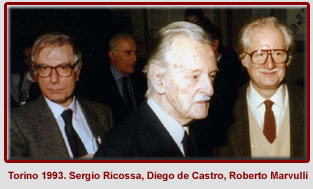 Though
far from academic life, he is still interested in it, especially
in promoting culture and the scientific research. With great generosity
he has constituted the foundation "Franca e Diego de Castro" that
links the two universities of Turin and Trieste. Scholarships
and financing of research projects are among the most important
purposes of this Foundation. Though
far from academic life, he is still interested in it, especially
in promoting culture and the scientific research. With great generosity
he has constituted the foundation "Franca e Diego de Castro" that
links the two universities of Turin and Trieste. Scholarships
and financing of research projects are among the most important
purposes of this Foundation.
Diego de Castro died on 13th June 2003 in Roletto (Pinerolo) and he was buried in Pirano cemetery.
Rosanna Panelli


|
Diego de Castro, Breve storia della
mia famiglia, in Marino Bonifacio, Cognomi del Comune
di Pirano, "Lasa Pur Dir", n. 11, Ed. il Trillo, Pirano,
1996, pp. 3-19. Marino Bonifacio, Cognomi del Comune
di Pirano, "Lasa Pur Dir", n. 11, Ed. il Trillo, Pirano,
1996, pp. 20-24, pp. 67-82.
|
 |
| |
|

|
Diego de Castro, La statistica giudiziaria
penale, in "Annali di Statistica", Istituto Centrale
di Statistica del Regno d'Italia, Serie VI, Vol. XXIV, 1932,
Libreria dell'Istituto Poligrafico dello Stato, Roma, 1932,
pp. 288.
|
 |
| |
 |

|
Diego de Castro, Il problema di Trieste.
Genesi e sviluppi della questione giuliana in relazione
agli avvenimenti internazionali (1943-1952), Cappelli,
Bologna, 1953, pp. 680.
|
 |
| |
 |

|
Diego de Castro, La questione di Trieste.
L'azione politica e diplomatica, dal 1943 al 1954, Lint,
Trieste, 1981, vol. I, pp. 956, vol. II pp. 1112.
|
 |
| |
 |

|
Diego de Castro, Memorie di un novantenne.
Trieste e l'Istria, MGS Press, Trieste, 1999, pp.262.
|
 |
| |
 |

|
Flavio Forlani, Intitolata a De Castro
la biblioteca piranese, in "La voce del popolo", 16
Giugno 1997.
|
 |
| |
 |
|

